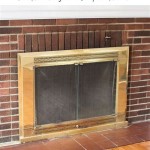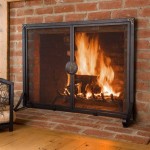Non-Gas Fireplace Inserts: A Comprehensive Overview
Fireplace inserts offer a way to enhance the efficiency and aesthetics of existing masonry or prefabricated fireplaces. While gas fireplace inserts are a popular choice, non-gas alternatives provide distinct advantages and cater to specific needs and preferences. These inserts, powered by electricity, wood pellets, or other fuel sources, can significantly reduce energy costs, improve heating performance, and offer a cleaner, more sustainable heating option.
The purpose of a fireplace insert is to convert an open-hearth fireplace, known for its low efficiency, into a more effective heating appliance. Traditional fireplaces lose a significant portion of heat up the chimney. Inserts, on the other hand, are designed to capture and radiate heat into the room, minimizing heat loss and improving overall heating effectiveness. This makes them a practical choice for homeowners seeking to supplement their primary heating system or reduce their reliance on fossil fuels.
Choosing the right non-gas fireplace insert requires careful consideration of factors. Understanding the different types of non-gas inserts available, their heating capabilities, installation requirements, and associated costs is essential for making an informed decision. Furthermore, knowing the advantages and disadvantages of each type allows homeowners to select the insert that best suits their individual needs and home environment.
Electric Fireplace Inserts: Convenience and Versatility
Electric fireplace inserts are a popular choice due to their ease of installation and operation. They require no venting or chimney, making them suitable for homes without existing fireplaces or for those looking for a hassle-free installation. These inserts typically plug directly into a standard electrical outlet, and their heating output can be controlled with a thermostat or remote control.
Electric fireplace inserts work by using electric coils to generate heat. A fan then circulates the warm air into the room. Most models feature realistic flame effects, often created using LED technology, which adds to the ambiance and aesthetic appeal. These flame effects can be operated independently of the heating function, allowing homeowners to enjoy the visual appeal of a fire without the heat.
The heating capacity of electric fireplace inserts is generally measured in British Thermal Units (BTUs) or wattage. A typical electric insert can produce between 4,000 and 5,000 BTUs, which is sufficient to heat a medium-sized room. However, it's important to consider the size of the room and the desired heating level when selecting an electric insert. Larger rooms may require a more powerful insert or supplemental heating.
One of the key advantages of electric fireplace inserts is their safety. They produce no combustion byproducts, such as carbon monoxide, and the exterior of the unit remains cool to the touch, reducing the risk of burns. They are also relatively inexpensive to operate, especially when used as supplemental heating in a specific room.
However, electric fireplace inserts rely on electricity to operate, which can be a disadvantage during power outages. Their heating capacity may also be limited compared to other types of inserts, such as wood pellet or wood-burning models. The visual appeal of the flames, while realistic, may not fully replicate the look and feel of a real fire for some individuals.
Wood Pellet Fireplace Inserts: Efficient and Eco-Friendly Heating
Wood pellet fireplace inserts offer a blend of efficiency, environmental friendliness, and heating power. They burn compressed wood pellets, a renewable resource made from recycled wood waste. These pellets are automatically fed into the firebox by an auger, ensuring a consistent and controlled burn.
Pellet inserts boast high heating efficiency, often exceeding 80%. This means that a significant portion of the energy contained in the pellets is converted into usable heat, minimizing waste and reducing heating costs. They also produce relatively low emissions compared to traditional wood-burning fireplaces, making them a cleaner heating option.
The heat output of wood pellet inserts is typically adjustable, allowing homeowners to control the temperature and optimize fuel consumption. Many models feature programmable thermostats, which can automatically adjust the heating output based on the desired temperature and schedule.
Compared to electric inserts, wood pellet inserts generally offer greater heating capacity. They can effectively heat larger areas and provide a more substantial source of warmth. However, they require a chimney or venting system to exhaust combustion gases. Installation typically involves connecting the insert to an existing chimney or installing a new vent pipe.
One of the main considerations with wood pellet inserts is the need to purchase and store wood pellets. While pellets are relatively inexpensive compared to other heating fuels, the cost can vary depending on availability and location. Storage space is also required to keep the pellets dry and protected from the elements. Additionally, the auger and other mechanical components require occasional maintenance to ensure proper operation.
Other Non-Gas Fireplace Insert Options
Beyond electric and wood pellet inserts, other non-gas options exist, although they are less common. These may include ethanol fireplace inserts and coal-burning fireplace inserts. Each of these options possesses distinct operational characteristics and specific considerations.
Ethanol fireplace inserts burn denatured alcohol, a renewable fuel source. They are ventless, meaning they do not require a chimney or venting system. This makes them a relatively easy option to install. They produce a real flame and provide some heat, but the heating capacity is typically lower than wood pellet or some electric inserts. Ethanol fireplace inserts are often chosen for their aesthetic appeal and ease of use rather than their heating efficiency.
The main advantage of ethanol inserts is their clean burning properties. They produce no smoke, ash, or soot. However, they do require the purchase of ethanol fuel, which can be more expensive than other fuel options. The flames produced by ethanol inserts can also be more susceptible to drafts, and it is important to ensure proper ventilation in the room to prevent the buildup of carbon dioxide.
Coal-burning fireplace inserts are less common due to environmental concerns and the relative inconvenience of handling coal. They require a chimney or vent system and can produce significant amounts of ash and soot. While coal can provide a substantial amount of heat, it is also a relatively dirty burning fuel. Coal-burning inserts are typically chosen by individuals who have access to a readily available and affordable source of coal.
Overall, the choice of a non-gas fireplace insert depends on various factors, including desired heating output, budget, installation requirements, and personal preferences. Understanding these factors ensures that the selected insert appropriately addresses these elements.
Key Considerations Before Purchasing
Before purchasing any non-gas fireplace insert, it is crucial to carefully assess several factors to ensure a successful and satisfying investment. These considerations include the size of the fireplace opening, the heating needs of the space, the availability of fuel or power, and any applicable building codes or regulations.
The fireplace opening must be accurately measured to ensure that the insert will fit properly. Most inserts are designed to fit standard-sized fireplaces, but it is important to verify the dimensions before making a purchase. Some inserts may require modifications to the fireplace opening, such as removing or altering the firebox, to ensure a secure and proper fit.
The heating needs of the space should also be carefully assessed. Consider the size of the room, the insulation level, and the climate when determining the appropriate heating capacity. A larger room or a poorly insulated home will require a more powerful insert to achieve the desired level of warmth. It is advisable to consult with a qualified heating professional to determine the optimal BTU output for the specific space.
The availability of fuel or power is another important consideration. Electric inserts require a readily available electrical outlet with sufficient amperage. Wood pellet inserts require a reliable source of wood pellets and adequate storage space. Ethanol inserts require a consistent supply of ethanol fuel. Ensure that the chosen fuel or power source is readily available and affordable before making a purchase.
Finally, it is essential to check for any applicable building codes or regulations. Some jurisdictions may have specific requirements for the installation of fireplace inserts, such as venting requirements or safety regulations. Obtain the necessary permits and ensure that the installation complies with all local codes.
Proper installation is paramount for the safe and efficient operation of any fireplace insert. It is highly recommended to hire a qualified professional to install the insert, especially if it involves venting or electrical work. Incorrect installation can lead to safety hazards, such as carbon monoxide poisoning or fire. A professional installer can ensure that the insert is properly installed and that all safety precautions are followed.
:max_bytes(150000):strip_icc()/ventless-gas-fireplaces-4160746-hero-f9d4bdcd9bd446eb84406de306f790ba.jpg?strip=all)
How To Pick Out A Ventless Gas Fireplace

Electric Fireplaces A Safe Alternative To Gas Touchstone Home S Inc

Fireplace Insert Vs Zero Clearance Maple Mtn

Vent Free Inserts White Mountain Hearth

Zero Clearance Vs Prefabricated Fireplace Full Service Chimney

What Is A Ventless Gas Fireplace Experts In Gaithersbutg Md
.aspx?strip=all)
Fireplaces That Work Without Power Be Storm Ready With Regency

Fireplace Inserts Everything You Need To Know Full Service Chimney
.aspx?strip=all)
Fireplaces That Work Without Power Be Storm Ready With Regency

Procom Fbnsd28t 26 000 Btu Vent Free Dual Fuel Fireplace Build Com








